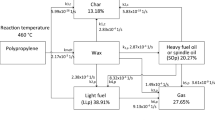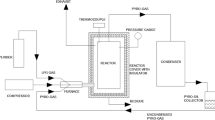Abstract
One of the greatest challenges in the world is in the final disposal of plastics in order to reduce the effect of its polluting potential. Thus, the application of pyrolysis processes in generating products of interest such as fuel oils can be part of the solution. In addition to reducing greenhouse gas emissions to the atmosphere, oil can enter the supply chain after the cracking process in petrochemical industries. In this context, this work used statistical modeling of the response surface linked to the normal boundary intersection algorithm, aiming at a higher yield of oil production and major selectivity of recycled polypropylene pyrolysis. From the analysis of the mechanisms proposed in the literature with the modeling and optimization in this work, it was possible, from a kaolin mass of 9.12 g and a heating ramp of 19.37 °C/min, to obtain higher percentages of aviation kerosene as well as a satisfactory performance.
Graphical abstract












Similar content being viewed by others
Data availability
All data generated or analyzed during this study are included in this published article [and its supplementary information files].
References
Cai N, Xia S, Li X et al (2021) Influence of the ratio of Fe/Al2O3 on waste polypropylene pyrolysis for high value-added products. J Clean Prod 315:1–4. https://doi.org/10.1016/j.jclepro.2021.128240
Czajczyńska D, Anguilano L, Ghazal H et al (2017) Potential of pyrolysis processes in the waste management sector. Therm Sci Eng Prog 3:171–197. https://doi.org/10.1016/j.tsep.2017.06.003
Das I, Dennis J (1996) Normal-boundary intersaction: an alternative method for generating pareto optimal points in multicriteria optimization problems. ICASE Repo, Hampton
Erawati E, Hamid MD (2020) Kinetic study on the pyrolysis of low-density polyethylene (LDPE) waste using kaolin as catalyst. IOP Conf Ser Mater Sci Eng. https://doi.org/10.1088/1757-899X/778/1/012071
Eze WU, Madufor IC, Onyeagoro GN et al (2021) Study on the effect of Kankara zeolite-Y-based catalyst on the chemical properties of liquid fuel from mixed waste plastics (MWPs) pyrolysis. Polym Bull 78:377–398. https://doi.org/10.1007/s00289-020-03116-4
Hu Q, Tang Z, Yao D et al (2020) Thermal behavior, kinetics and gas evolution characteristics for the co-pyrolysis of real-world plastic and tyre wastes. J Clean Prod 260:121102. https://doi.org/10.1016/j.jclepro.2020.121102
Joshi CA, Seay JR (2020) Total generation and combustion emissions of plastic derived fuels: a trash to tank approach. Environ Prog Sustain Energy 39:1–10. https://doi.org/10.1002/ep.13151
Kruse TM, Wong H, Broadbelt LJ (2003) Mechanistic modeling of polymer pyrolysis: polypropylene. pp. 9594–9607
Kumar S, Prakash R, Murugan S, Singh RK (2013) Performance and emission analysis of blends of waste plastic oil obtained by catalytic pyrolysis of waste HDPE with diesel in a CI engine. Energy Convers Manag 74:323–331. https://doi.org/10.1016/j.enconman.2013.05.028
Lechleitner AE, Schubert T, Hofer W, Lehner M (2021) Lumped kinetic modeling of polypropylene and polyethylene co-pyrolysis in tubular reactors. Processes 9:1–15. https://doi.org/10.3390/pr9010034
Luo W, Hu Q, Yi FZ et al (2020) The effect of different particle sizes and HCl-modified kaolin on catalytic pyrolysis characteristics of reworked polypropylene plastics. Energy 213:119080. https://doi.org/10.1016/j.energy.2020.119080
Mariappan M, Panithasan MS, Venkadesan G (2021) Pyrolysis plastic oil production and optimisation followed by maximum possible replacement of diesel with bio-oil/methanol blends in a CRDI engine. J Clean Prod 312:127687. https://doi.org/10.1016/j.jclepro.2021.127687
Myers RH, Montgomery DC, Anderson-Cook CM (2013) Response surface methodoly: process and product optimization using designed experiments
Naves FL (2019) Normal boundary intersection applied to controllers in environmental controls. In: Rinken T (ed) Environmental biosensors
Pinto MB, Samanamud GRL, Baston EP et al (2019) Multivariate and multiobjective optimization of tannery industry effluent treatment using Musa sp flower extract in the coagulation and flocculation process. J Clean Prod 219:655–666. https://doi.org/10.1016/j.jclepro.2019.02.060
Rahimi S, Yousefi MR, Rostamizadeh M (2021) Metal-doped high silica ZSM-5 nanocatalyst for efficient conversion of plastic to value-added hydrocarbons. Polym Degrad Stab 191:109653. https://doi.org/10.1016/j.polymdegradstab.2021.109653
Santos P, Costa M, Leite A (2019) O caulim no depósito de fosfatos de alumínio de sapucaia (Bonito-Pará). Bol Do Mus Geociências Da Amaz 6:1–10. https://doi.org/10.31419/issn.2594-942x.v62019i2a5phcs
Sivagami K, Divyapriya G, Selvaraj R et al (2020) Catalytic pyrolysis of polyolefin and multilayer packaging based waste plastics: a pilot scale study. Process Saf Environ Prot 149:497–506. https://doi.org/10.1016/j.psep.2020.10.038
Srinivasan S, Saifee A, Begum SS, Baran A (2021) Experimental investigation on the influence of novel catalyst in co-pyrolysis of polymeric waste: characterization of oil and preparation of char reinforced composites. J Clean Prod 316:128225. https://doi.org/10.1016/j.jclepro.2021.128225
Thahir R, Altway A, Juliastuti SR, Susianto A (2019) Production of liquid fuel from plastic waste using integrated pyrolysis method with refinery distillation bubble cap plate column. Energy Rep 5:70–77. https://doi.org/10.1016/j.egyr.2018.11.004
Acknowledgements
We would like to thank the Federal University of São João del Rei–UFSJ and the Research Group on Waste Treatment and Management Processes. The authors thank Coordination for the Improvement of Higher Education Personnel (CAPES) and Research Support Foundation of the State of Minas Gerais (FAPEMIG–TO FAPEMIG APQ-00559-21) for financial support to conduct this work.
Funding
The authors have not disclosed any funding
Author information
Authors and Affiliations
Corresponding author
Ethics declarations
Competing interest
The authors have not disclosed any competing interest.
Additional information
Publisher's Note
Springer Nature remains neutral with regard to jurisdictional claims in published maps and institutional affiliations.
Rights and permissions
Springer Nature or its licensor (e.g. a society or other partner) holds exclusive rights to this article under a publishing agreement with the author(s) or other rightsholder(s); author self-archiving of the accepted manuscript version of this article is solely governed by the terms of such publishing agreement and applicable law.
About this article
Cite this article
dos Santos, H.A., Santos, I.J.B., Quintão, C.M.F. et al. Modeling and optimization of the pyrolysis oil production process from polypropylene for the production of aviation kerosene. Clean Techn Environ Policy 25, 1385–1396 (2023). https://doi.org/10.1007/s10098-022-02450-7
Received:
Accepted:
Published:
Issue Date:
DOI: https://doi.org/10.1007/s10098-022-02450-7




